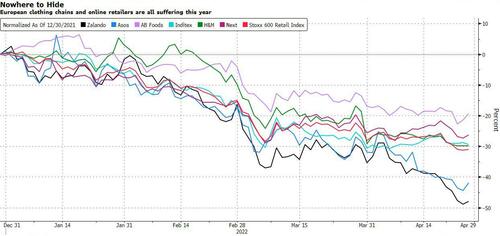
By Michael Msika and Lisa Pham, Bloomberg Markets live analysts and commentators
It’s been a tough year for retailers. And with high inflation giving shoppers less to spend, costs rising and supply chains under strain, even near-distressed stock valuations aren’t tempting investors just yet.
The Stoxx 600 Retail Index is the main benchmark’s worst-performing subgroup this year, down 30% and having fallen for four straight months. Valuations have plummeted from a forward price-earnings ratio of about 27 last year to below 15, the lowest since 2014. And trading at only a 10% premium to the broader market, retailers haven’t been this cheap on a relative basis since the global financial crisis.
“Retail has been hit hard by the ongoing pressures on gross margins,” says Mirabaud analyst Neil Campling. Investors “appear to lack conviction that we are past the hump” of headwinds that include risks of another central-bank taper tantrum, spiraling costs, adverse currency moves and logistics and labor shortages, he says.
Recent signs haven’t been encouraging. Primark owner AB Foods warned last week about the impact of soaring prices in Britain. Prior to that, Asos said its full-year earnings goal is at risk from inflation and disruption from war in Ukraine, while H&M reported a sudden slowdown in revenue growth and earnings that missed estimates. In the U.S., Gap shares slumped after the firm cut its outlook.
Bank of America analysts including Geoffroy de Mendez see a risk to the annual clothing and footwear budgets of consumers in the U.K. and Germany, who on average spend 3% to 4% of their money on such items. Those on low-to middle incomes, typically target customers of Asos, Boohoo and Zalando, are viewed as particularly vulnerable.
The outlook for British retailers appears especially difficult, with consumer confidence at its lowest level since 2008. “We think that the U.K. is more vulnerable to an income shock,” says Frederique Carrier, head of investment strategy at RBC Wealth Management, citing higher energy prices than in rest of Europe and rising taxes.
Frederic Rollin, senior investment adviser at Pictet Asset Management, says he hasn’t yet decided to return to the sector.
“In Europe, there are still retail sales that are rather strong but consumer confidence has collapsed, and we would want a bit more visibility on that before coming back,” he says.
Still, others sense opportunities in weakness. GAM investment director Niall Gallagher cites online retailer Zalando, which has fallen about 50% this year. “That stock had been quite expensive, we now think that it’s actually becoming cheap, if not very cheap, based on the long-term prospects of the business,” he says.
By Michael Msika and Lisa Pham, Bloomberg Markets live analysts and commentators
It’s been a tough year for retailers. And with high inflation giving shoppers less to spend, costs rising and supply chains under strain, even near-distressed stock valuations aren’t tempting investors just yet.
The Stoxx 600 Retail Index is the main benchmark’s worst-performing subgroup this year, down 30% and having fallen for four straight months. Valuations have plummeted from a forward price-earnings ratio of about 27 last year to below 15, the lowest since 2014. And trading at only a 10% premium to the broader market, retailers haven’t been this cheap on a relative basis since the global financial crisis.
“Retail has been hit hard by the ongoing pressures on gross margins,” says Mirabaud analyst Neil Campling. Investors “appear to lack conviction that we are past the hump” of headwinds that include risks of another central-bank taper tantrum, spiraling costs, adverse currency moves and logistics and labor shortages, he says.
Recent signs haven’t been encouraging. Primark owner AB Foods warned last week about the impact of soaring prices in Britain. Prior to that, Asos said its full-year earnings goal is at risk from inflation and disruption from war in Ukraine, while H&M reported a sudden slowdown in revenue growth and earnings that missed estimates. In the U.S., Gap shares slumped after the firm cut its outlook.
Bank of America analysts including Geoffroy de Mendez see a risk to the annual clothing and footwear budgets of consumers in the U.K. and Germany, who on average spend 3% to 4% of their money on such items. Those on low-to middle incomes, typically target customers of Asos, Boohoo and Zalando, are viewed as particularly vulnerable.
The outlook for British retailers appears especially difficult, with consumer confidence at its lowest level since 2008. “We think that the U.K. is more vulnerable to an income shock,” says Frederique Carrier, head of investment strategy at RBC Wealth Management, citing higher energy prices than in rest of Europe and rising taxes.
Frederic Rollin, senior investment adviser at Pictet Asset Management, says he hasn’t yet decided to return to the sector.
“In Europe, there are still retail sales that are rather strong but consumer confidence has collapsed, and we would want a bit more visibility on that before coming back,” he says.
Still, others sense opportunities in weakness. GAM investment director Niall Gallagher cites online retailer Zalando, which has fallen about 50% this year. “That stock had been quite expensive, we now think that it’s actually becoming cheap, if not very cheap, based on the long-term prospects of the business,” he says.







